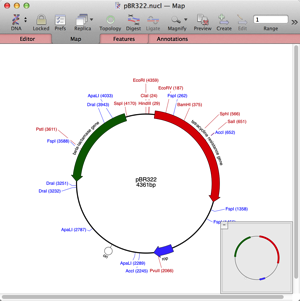

BLAST searches done through MacVector are now carried out with NCBI's enhanced BLAST 2.0 programs, which permit gapped alignments. Other notable features in version 7.0 include additional algorithms for identifying coding regions, and an improved multiple sequence alignment editor. New in version 7.0 is the ability to generate true phylogenetic trees with the use of distance matrix methods. Such features offer an improvement over version 6.5 )]. Another useful feature is the ability to perform BLAST searches, where a query sequence is compared with sequences in databases accessible through the Internet, without leaving the program. MacVector will also retrieve protein or nucleic acid sequences of interest from databases by conducting an Internet search, which is trivial to set up as well as extremely fast. Protein sequences may be analyzed to determine (among other things) the molecular weight and pI (isoelectric pH) of the protein of interest and to obtain profiles of hydrophilicity, antigenicity, and secondary structure along the length of the protein. A short, but by no means complete, list of nucleic acid analyses available includes restriction mapping, open reading frame searches to identify protein coding regions within a sequence, base composition and codon usage analyses, nucleic acid subsequence motif searches, primer design for PCR (polymerase chain reaction), multiple sequence alignments, and translation of open reading frames to the corresponding amino acid sequences. MacVector is designed to be used on Macintosh computers, and has a well-deserved reputation for being swift, powerful, and amazingly easy to use.
#Macvector windows software
One such software package is called MacVector, the latest release of which provides the molecular biologist with a wide variety of tools for analyzing nucleic acid and protein sequences. A convenient if more expensive alternative is to buy a comprehensive sequence analysis program designed to perform the most commonly used analyses with a single, user-friendly interface. This variability can be frustrating if one needs to carry out a variety of analyses fairly often. There are, of course, numerous shareware programs on the Web, but most of these will perform a single type of analysis (e.g., identifying restriction enzyme recognition sites) and each has a different user interface.

As whole genomes find their way into the databases, the probability is ever greater that a sequence of interest is only a BLAST search away.Īlthough the power of the Internet makes enormous amounts of sequence data readily accessible, molecular biologists still need tools to help them with routine sequence analysis tasks such as restriction mapping, identifying protein coding regions or special sequence motifs, and carrying out sequence similarity searches. Thus, instead of wandering around labs with tubes of radioactive probes, scientists are often found at their desks, peering hopefully at their computer screens. T his is an era in which molecular biologists can often obtain gene sequences of interest by searching databases rather than by screening libraries of cloned DNA fragments.


 0 kommentar(er)
0 kommentar(er)
